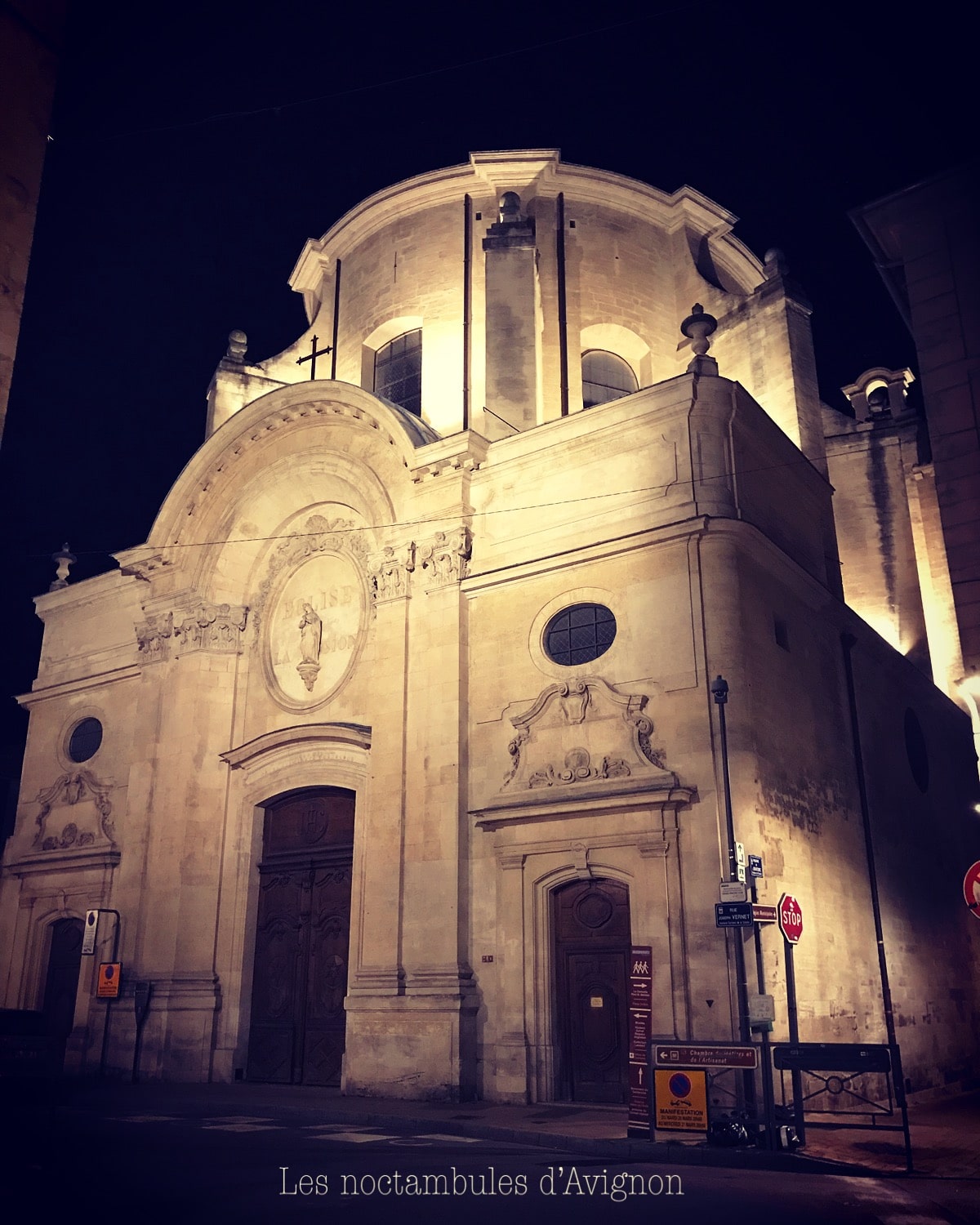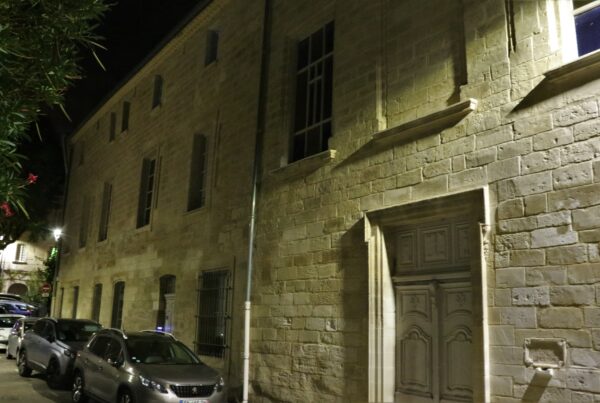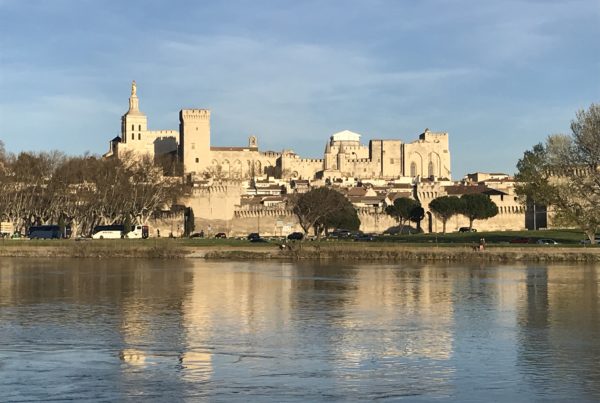Avignon, city of the Popes and jewel of Provencal heritage, is more than just its famous palace and mythical bridge. As you wander through its cobbled streets and shady squares, the city reveals another treasure: its churches. Reflecting centuries of faith, art and history, these religious buildings bear witness to Avignon’s spiritual and artistic influence throughout the ages. We invite you to take a journey through the churches in Avignon.
From flamboyant Gothic to sober Romanesque, from discreet chapels to majestic cathedrals, each church tells a page in Avignon’s history. Whether you’re an architecture enthusiast, a history buff or just a curious walker, these places invite you to contemplate and marvel.
In this article, we take a look at the five most beautiful churches in Avignon – those whose beauty, uniqueness or historical importance make them absolutely worth a visit.
Number 5 most beautiful churches in Avignon: The collegiate church of Saint Agricole
Located in the heart of Avignon, the collegiate church of Saint Agricol is an emblematic building that bears witness to the city’s rich history and spirituality.
History of the church
Saint Agricol, born around 630, was bishop of Avignon from 660 to 700. Renowned for his charity towards the poor and the sick, he founded a church on the site of what is now the collegiate church. After his death, he was venerated as the patron saint of Avignon, and his relics are now kept in the church that bears his name. A miracle is attributed to him. After yet another flood, the city suffered from an invasion of snakes. Saint Agricol prayed and a horde of storks came to rid the town of the invaders. The church’s stained glass windows show Saint Agricol with a stork holding out a snake.
Visit the church
The current building, constructed in the early XIVᵉ century on the foundations of the primitive church, was elevated to the rank of collegiate church by Pope John XXII in 1321. Built in the Gothic style, the collegiate church of Saint Agricol is the only church in Avignon of this period to have side aisles. Its facade, built in 1485 by Antoine Colin of Lyon and Didier Millot of Toul, features a polychrome tympanum sculpted by Ferrier Bernard in 1488-1489.
The interior of the church contains numerous works of art, including paintings by Simon de Châlons and Nicolas Mignard, as well as tombs and various inscriptions. The Baroque main altar, sculpted by Jean-Baptiste II Péru in 1767, contains the relics of Saint Agricol and his father, Saint Magnus.
The collegiate church is open to visitors all year round. Opening times are as follows: Monday to Friday from 10am to 7pm, Saturday from 10am to 5pm, and Sunday from 9.30am to 12pm. Masses are celebrated from Monday to Friday at 6.30pm, and on Sundays at 10.30am. These times are subject to change depending on the availability of supervisory staff.
Number 4: Notre dame des Doms
Standing majestically on the rock of Les Doms, Notre Dame des Doms cathedral is the spiritual heart of Avignon and one of its most emblematic buildings.
History of the church
Built in the XIIᵉ century, at a time when Avignon was becoming a major religious centre, it is a remarkable example of Provençal Romanesque art. Erected on a formerly pagan site dedicated to the goddess Diana, the cathedral was consecrated in 1111, then modified over the centuries: a bell tower rebuilt in the 15th century, a Baroque apse added in the 17th, and the famous golden statue of the Virgin Mary, over 6 metres high, placed at the top of the bell tower in 1859, the protective symbol of the city. It is the only Roman-style church in the city, and the only one with more than one style inside.
Inside the church
At the entrance, two statues watch over visitors: Saint Martha and Saint Mary Magdalene, biblical figures deeply rooted in the legends of Provence. According to Provençal tradition, these two saints landed in the Camargue after fleeing persecution in the Holy Land. Marie-Madeleine is said to have lived as a hermit in the Sainte Baume cave, while Marthe is said to have evangelised Tarascon and struck down the Tarasque, a legendary monster. Their symbolic presence at the entrance to the cathedral is a reminder of the local roots of these holy stories and the role played by women in spreading Christianity in Provence.
The cathedral’s interior also contains some real treasures: the Gothic mausoleum of Pope John XXII, a work of great finesse from the 14th century, the white marble episcopal cathedra dating from the Romanesque period, and several richly decorated chapels. The church suffered greatly during the French Revolution. Used as a stable, all the murals disappeared. It was only after the signing of the Concordat that it became a cathedral again. Today, it is a private church with 19th-century furniture and paintings, but if you look hard enough, you’ll discover paintings from the Middle Ages.
The cathedral is open to visitors all year round. Opening times vary according to the season, but in general it welcomes visitors from Tuesday to Sunday, with Masses celebrated during the week at 7.30am and on Sundays at 11am. As well as being an active place of worship, it is a must-see for anyone wishing to understand the soul of Avignon.
Number 3: The Church of the Black Penitents
Nestling in the heart of Avignon, the Chapelle des Pénitents Noirs is a jewel of Baroque art, bearing witness to the rich tradition of the brotherhoods of penitents that have marked the city’s religious history.
The Brotherhoods of Penitents in Avignon
The Confréries de Pénitents are associations of lay Catholics dedicated to prayer, penance and works of charity. First appearing in Italy in the XIIᵉ century, they quickly spread to France. Avignon, in particular, saw the birth of several of these confraternities, each identified by the colour of its members’ habit. The first of these, the Confrérie des Pénitents Gris, was founded in 1226 by King Louis VIII, following the siege of Avignon. Others followed, notably the Pénitents Noirs, Blancs, Bleus, Violets and Rouges, each group adopting specific missions, such as assisting the sick, prisoners or those condemned to death.
The Chapel of the Pénitents Noirs
The Confrérie des Pénitents Noirs de la Miséricorde was founded in 1586 by Pompey Catilina, a Florentine nobleman and colonel of the Papal infantry in Avignon. This brotherhood was mainly dedicated to helping those condemned to death and the mentally ill. In fact, when you enter the church, on your left you will find an urn for donations to those condemned to death and on the other side an urn for donations to the insane (mentally ill). In 1591, it acquired the Notre-Dame de Fenouillet chapel in rue de la Banasterie, which became their place of worship. The chapel underwent a number of transformations over the centuries, including a partial reconstruction in 1739 by the architect Thomas Lainée, who designed the current façade featuring a bas-relief depicting the head of Saint John the Baptist. It is the only church in Avignon in the Baroque style.
Listed as a Historic Monument in 1906, the chapel has been restored to preserve its rich artistic heritage. The interior houses works by renowned painters such as Nicolas Mignard, Pierre and Joseph François Parrocel, and Reynaud Levieux, although some of the original canvases were dispersed during the Revolution.
Opening times and Offices
The chapel is open to visitors all year round, mainly on Saturdays from 2pm to 5pm. From 1 April to 30 September, it is also open on Fridays at the same times. In July, visits are by appointment only. Admission is free.
Religious services are held here by the Priestly Fraternity of Saint Pius X (FSSPX). Sunday mass is at 10am, and during the week, masses are celebrated on Thursdays at 6.30pm (except in July) and on Saturdays at 11.15am (except in July).
The Chapelle des Pénitents Noirs is a living testimony to the spirituality and charitable commitment of the brotherhoods of Avignon over the centuries.
Number 2: Saint-Pierre Basilica, the most beautiful Gothic façade in Avignon
Located in the heart of Avignon, Saint-Pierre Basilica is a remarkable Gothic building. It has the most beautiful flamboyant Gothic façade in the city. It’s one of the many reasons why I’ve chosen to list this church as one of the most beautiful in Avignon.
History of Saint-Pierre church
According to tradition, a first church was built on this site in the VIIᵉ century, then destroyed by the Saracens. Its reconstruction began in the XIVᵉ century thanks to the generosity of Cardinal Pierre des Prés, who in 1358 financed the construction of the canons’ buildings and the cloister, which has now disappeared. Pope Innocent VI then elevated the church to the rank of collegiate church. In the XVᵉ century, side chapels were added and the nave was enlarged, giving the building its current size.
Why visit this church?
One of the treasures of the basilica is its monumental solid walnut portals, commissioned in 1551 by the wealthy merchant Michel Lopis and created by the sculptor Antoine Volard. Each doorway is four metres high and decorated with porticoes in relief depicting figures under three-dimensional arches. The central overmantel is topped by a remarkable sculpted canopy, housing a statue of the Virgin and Child attributed to Jean Péru. They are considered to be the finest example of Provençal mannerism.
The basilica also houses the relics of Blessed Pierre de Luxembourg, bishop of Metz and cardinal in the XIVᵉ century, known for his piety and charity towards the poor. He died in 1387 at the age of 18 and was beatified in 1527. His relics, notably his dalmatic and cardinal’s hat, are carefully preserved in the church, testifying to his spiritual importance to the city of Avignon. Legend has it that over 1,900 miracles took place at his tomb.
The interior of the basilica is adorned with numerous works of art, including paintings by Simon de Châlons, Joseph Parrocel and Nicolas Mignard, enriching the cultural heritage of this sacred building. Like all the town’s religious monuments, the church suffered during the French Revolution. It is still possible to imagine its former luxury.
St Peter’s Basilica, a listed historic monument since 1840, remains a place of meditation and discovery for believers and tourists alike. Opening times depend on the availability of the volunteers who look after the church.
The most beautiful church in Avignon: the collegiate church of Saint-Didier
Located in the heart of Avignon’s historic centre, the collegiate church of Saint-Didier is without doubt one of the city’s most beautiful churches. It is a jewel of the Southern Gothic style. It was built between 1356 and 1359 thanks to the generosity of Cardinal Bertrand de Déaux. Its elegant sobriety is inspired by Cistercian art, which was very much in vogue at the papal court in Avignon. Its imposing octagonal bell tower and single vaulted nave create a space that is both majestic and refined, ideal for meditation.
The treasure of Saint-Didier church
The church is also home to a number of spiritual and artistic treasures. Among them is the tomb of Saint-Bénézet, the famous builder of the Pont d’Avignon. Just opposite is that of Blessed Pierre de Luxembourg, a young cardinal with an exceptional destiny. Both were initially buried in the Célestins church. Their relics were transferred to Saint-Didier during the French Revolution to protect them from desecration. Their presence here gives the church a unique aura, steeped in history and devotion.
Among the masterpieces preserved at Saint-Didier is The Carrying of the Cross, a striking bas-relief created in 1478 by Francesco Laurana at the request of King René of Anjou. This monumental work, considered to be one of the earliest marks of the Renaissance in France, bears witness to the artistic refinement of Avignon at the end of the Middle Ages.
Visit the church
The collegiate church of Saint-Didier, recognised as a historic monument in 1983, welcomes visitors all year round. Access is free, but silence is required. It remains a living place of prayer and remembrance. To find out about mass times or guided tours, please contact the parish directly.
Discover the churches in Avignon by night
Les Noctambules d’Avignon invites you to discover the churches in Avignon on a variety of routes. Come and discover the history of these churches and their charm with public lighting. Book your experience now so you don’t miss out on this unique discovery.





